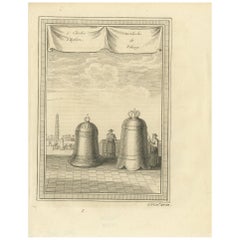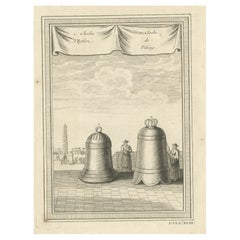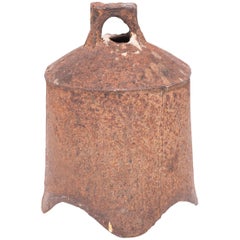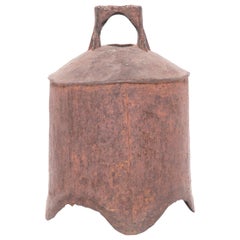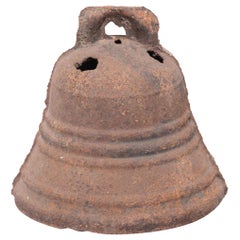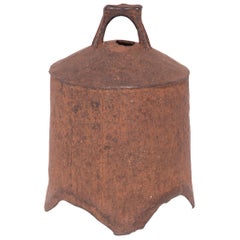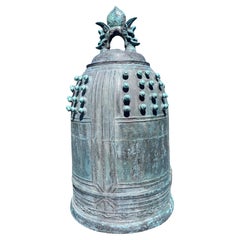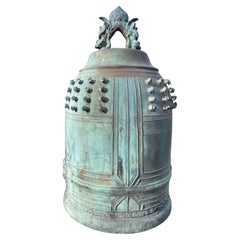Antique Chinese Bells
Mid-18th Century Antique Chinese Bells
Paper
18th Century Antique Chinese Bells
Paper
Mid-19th Century Chinese Qing Antique Chinese Bells
Iron
Mid-19th Century Chinese Rustic Antique Chinese Bells
Iron
Early 20th Century Japanese Taisho Antique Chinese Bells
Bronze
Mid-19th Century Chinese Qing Antique Chinese Bells
Iron
Mid-19th Century Chinese Rustic Antique Chinese Bells
Iron
Early 20th Century Japanese Taisho Antique Chinese Bells
Bronze
Early 20th Century Japanese Taisho Antique Chinese Bells
Bronze
Early 17th Century Chinese Ming Antique Chinese Bells
Iron
Early 20th Century Japanese Showa Antique Chinese Bells
Bronze
15th Century and Earlier Chinese Medieval Antique Chinese Bells
Bronze
Early 20th Century Japanese Showa Antique Chinese Bells
Bronze
Early 20th Century Japanese Showa Antique Chinese Bells
Bronze
Early 19th Century Chinese Qing Antique Chinese Bells
Iron
Late 19th Century Chinese Artisan Antique Chinese Bells
Jade, Gold, Copper
Early 17th Century Chinese Ming Antique Chinese Bells
Iron
19th Century Chinese Qing Antique Chinese Bells
Brass, Bronze
18th Century Chinese Other Antique Chinese Bells
Brass
1920s Chinese Chinese Export Antique Chinese Bells
Brass, Wrought Iron
Early 20th Century Chinese Chinese Chippendale Antique Chinese Bells
Agate
Early 20th Century Antique Chinese Bells
Bronze
15th Century and Earlier Chinese Antique Chinese Bells
Bronze
19th Century Antique Chinese Bells
Bronze
Early 20th Century Chinese Archaistic Antique Chinese Bells
Bronze
19th Century Japanese Japonisme Antique Chinese Bells
Ceramic
Early 20th Century Japanese Showa Antique Chinese Bells
Bronze
19th Century Chinese Antique Chinese Bells
Iron
Late 19th Century Chinese Antique Chinese Bells
Bronze
18th Century and Earlier Chinese Antique Chinese Bells
Iron
Mid-19th Century Chinese Antique Chinese Bells
Iron
19th Century Chinese Antique Chinese Bells
Iron
Early 19th Century Chinese Georgian Antique Chinese Bells
Rosewood
19th Century Antique Chinese Bells
Rosewood
19th Century Chinese Antique Chinese Bells
Early 20th Century Chinese Antique Chinese Bells
Iron
Mid-19th Century Chinese Qing Antique Chinese Bells
Iron
Mid-19th Century Chinese Qing Antique Chinese Bells
Iron
18th Century and Earlier Chinese Antique Chinese Bells
Bronze
Mid-19th Century Chinese Qing Antique Chinese Bells
Iron
Mid-19th Century Chinese Rustic Antique Chinese Bells
Iron
Early 20th Century Japanese Taisho Antique Chinese Bells
Bronze
Mid-19th Century Chinese Primitive Antique Chinese Bells
Bronze
Early 20th Century Chinese Qing Antique Chinese Bells
Silver
Early 20th Century Japanese Showa Antique Chinese Bells
Bronze
19th Century Chinese Qing Antique Chinese Bells
Bronze
19th Century Chinese Qing Antique Chinese Bells
Bronze
Early 20th Century Chinese Chinoiserie Antique Chinese Bells
Copper, Enamel
1810s French Chinoiserie Antique Chinese Bells
Bronze
Early 20th Century Chinese Chinese Export Antique Chinese Bells
Brass
18th Century and Earlier Chinese Antique Chinese Bells
Iron
1920s Chinese Antique Chinese Bells
Brass
Early 20th Century Chinese Mid-Century Modern Antique Chinese Bells
Brass
19th Century Chinese Meiji Antique Chinese Bells
Bronze
Early 20th Century English Chinese Chippendale Antique Chinese Bells
Wood
Mid-19th Century Chinese Chinese Export Antique Chinese Bells
Porcelain
Mid-19th Century Chinese Antique Chinese Bells
Walnut
Mid-19th Century Chinese Qing Antique Chinese Bells
Limestone
- 1
Antique Chinese Bells For Sale on 1stDibs
How Much are Antique Chinese Bells?
- What is a Chinese Bell called?1 Answer
 Lotus GalleryMarch 17, 2021A Chinese bell is called a "zhong" 钟
Lotus GalleryMarch 17, 2021A Chinese bell is called a "zhong" 钟 - What are Chinese bronze bells?1 Answer1stDibs ExpertApril 5, 2022Chinese bronze bells are bells crafted from bronze that were used as instruments in China. Many were typically hung in a frame and used to create a melody by hitting them with a mallet. Some date back up to 3,600 years. They are also known as bianzhong. Shop a collection of Chinese bronze bells from top sellers on 1stDibs.
 PAGODA REDOctober 7, 2020
PAGODA REDOctober 7, 2020To determine the age of a Chinese furniture piece, look carefully at the joinery and finish. Natural expansion and contraction of the wood over time will cause a joint to protrude or retract, distorting a once-seamless fit. Antique lacquer finishes become crackled and worn over time. Areas of exposed wood, such as the underside of a table, the footrest of a chair, or the back of a cabinet should appear raw and dry compared to the finished surface. With use, the legs of tables and chairs become weathered near the bottom from precipitation and use.
 Lotus GallerySeptember 23, 2020
Lotus GallerySeptember 23, 2020The best way to know is to take it to an expert, such as an appraiser, reputable dealer or auction house, or museum
- 1stDibs ExpertNovember 4, 2024To identify antique Chinese furniture, look carefully at its details. Chinese craftsmen often built furniture using mortise and tenon joinery, eliminating the need for nails and screws. If you see this type of hardware, your piece is likely not at least 100 years old, especially if the hardware still looks new and shiny. Since antique furniture was handmade, you will normally see slight imperfections, such as tool marks or slight variations in carvings. Pieces that appear completely uniform and pristine are less often genuine antiques.
When present, maker's marks can also be helpful. Research the marks to learn more about when the maker was active and producing pieces like yours. Alternatively, you can have a certified appraiser or experienced antique dealer evaluate your furniture for you.
Shop an assortment of antique Chinese furniture.
